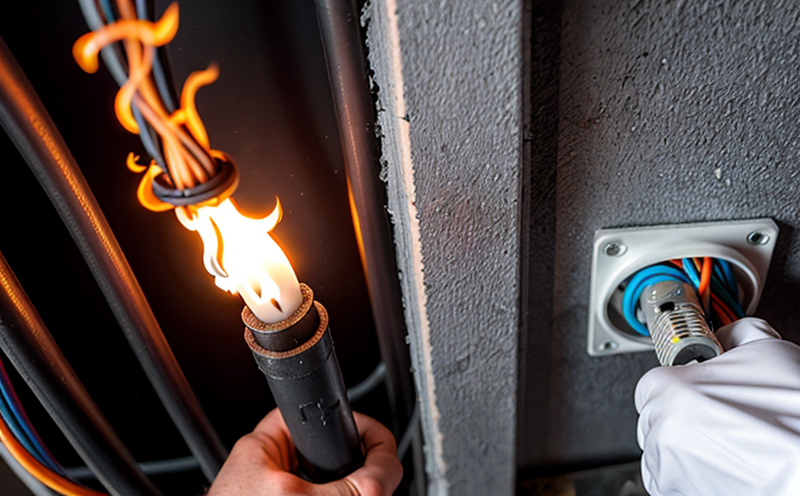Smoke Emission Testing of Low Voltage Cables
The testing and certification of low voltage cables are critical in ensuring that these materials meet strict safety standards. This section focuses on smoke emission testing, a crucial aspect of fire safety testing for cables and wiring systems.
This type of testing is especially important as it ensures that the materials used in electrical installations do not produce excessive smoke when exposed to flame, which can lead to poor visibility during emergencies. The objective is to assess whether the cable's insulation material releases toxic or flammable gases under fire conditions, thereby posing a risk to life and property.
The testing process involves subjecting the cable to controlled burning in an environment that simulates real-world scenarios. Smoke emission testing can be conducted using various apparatus such as the Cone Calorimeter (ISO 56602) or the Tunnel Test (EN 13823). The primary goal is to quantify the amount of smoke produced and its characteristics, which are then used to evaluate the cable's performance.
During testing, samples are prepared by cutting sections from a standard length of the low voltage cable. These samples undergo rigorous testing under specified conditions, including temperature, duration of exposure, and oxygen concentration within the combustion chamber. The results provide valuable insights into how the cable behaves in fire situations, which is essential for compliance with international standards like ISO 1363-2 and IEC 60332.
Understanding the smoke characteristics helps manufacturers improve their products by identifying areas where modifications can be made to reduce harmful emissions. The data obtained from these tests also aids in ensuring that installations are safe, minimizing potential risks associated with poor visibility due to heavy smoke release during fires. This information is vital for regulatory compliance and ensures that buildings meet fire safety standards.
Smoke emission testing of low voltage cables is not just a formality but an essential step towards safeguarding lives and properties. By adhering to these rigorous tests, manufacturers can demonstrate their commitment to quality and reliability in the materials they produce. This practice fosters trust among consumers who rely on safe and efficient electrical systems for daily operations.
The importance of this testing cannot be overstated, especially considering that fires are one of the leading causes of accidental deaths worldwide. Ensuring that the cables used in these applications meet stringent smoke emission standards can significantly reduce risks associated with such incidents.
| Applied Standards |
|---|
| ISO 1363-2: Smoke density and opacity of materials under fire exposure |
| IEC 60332-1: Resistance to ignition of single insulated wires and cables for general purposes |
| EN 13823: Cables for building structures - Determination of smoke production characteristics |
Applied Standards
The following international standards are commonly referenced in the context of smoke emission testing:
| Standard | Description |
|---|---|
| ISO 1363-2: Smoke density and opacity of materials under fire exposure | This standard provides methods for determining the smoke density and opacity produced by building products during a specified period when exposed to flames. It is particularly useful in evaluating the performance of low voltage cables. |
| IEC 60332-1: Resistance to ignition of single insulated wires and cables for general purposes | This standard specifies tests to determine the resistance to ignition of individual insulated wires and cables used for general purposes. Particular attention is given to preventing flame spread, which is crucial in environments where fire safety is paramount. |
| EN 13823: Cables for building structures - Determination of smoke production characteristics | This European standard outlines procedures for determining the smoke production characteristics of cables intended for use in buildings. It covers various aspects, including the measurement of smoke density and opacity. |
Quality and Reliability Assurance
- Precision control of environmental parameters to ensure consistent testing results.
- Detailed documentation of test procedures and outcomes for transparent reporting.
- Use of advanced instrumentation capable of accurately measuring smoke density, opacity, and other relevant parameters.
International Acceptance and Recognition
The results from smoke emission tests are widely recognized across different countries and regions. Compliance with these internationally accepted standards ensures that products meet the necessary safety requirements, thereby gaining market access in various jurisdictions.
Countries such as the United States, Canada, Europe, and Asia have adopted these standards to enhance public safety. By adhering to these norms, manufacturers can ensure their products are suitable for use in diverse environments, from residential buildings to industrial facilities.
The global acceptance of these tests underscores their significance in promoting fire safety practices worldwide. Compliance with international standards not only enhances product reliability but also fosters confidence among end-users and stakeholders.





